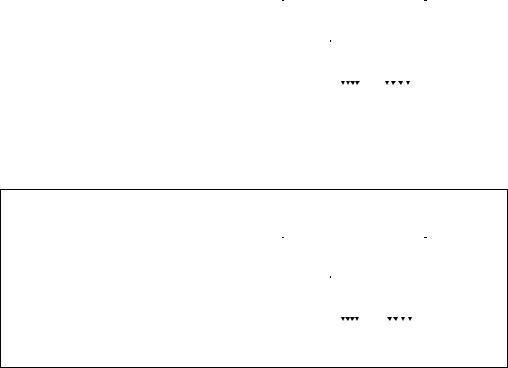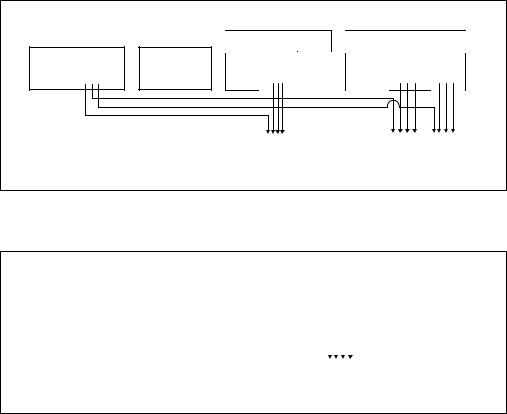
- •Contents
- •1.2 Overview of Volume 2A and 2B: Instruction Set Reference
- •1.3 Notational Conventions
- •1.3.1 Bit and Byte Order
- •1.3.2 Reserved Bits and Software Compatibility
- •1.3.3 Instruction Operands
- •1.3.4 Hexadecimal and Binary Numbers
- •1.3.5 Segmented Addressing
- •1.3.6 Exceptions
- •1.3.7 A New Syntax for CPUID, CR, and MSR Values
- •1.4 Related Literature
- •2.1.1 Instruction Prefixes
- •2.1.2 Opcodes
- •2.1.3 ModR/M and SIB Bytes
- •2.1.4 Displacement and Immediate Bytes
- •2.2.1 REX Prefixes
- •2.2.1.1 Encoding
- •2.2.1.2 More on REX Prefix Fields
- •2.2.1.3 Displacement
- •2.2.1.5 Immediates
- •2.2.2 Additional Encodings for Control and Debug Registers
- •3.1 Interpreting the Instruction Reference Pages
- •3.1.1 Instruction Format
- •3.1.1.1 Opcode Column in the Instruction Summary Table
- •3.1.1.2 Instruction Column in the Opcode Summary Table
- •3.1.1.4 Compatibility/Legacy Mode Column in the Instruction Summary Table
- •3.1.1.5 Description Column in the Instruction Summary Table
- •3.1.1.6 Description Section
- •3.1.1.7 Operation Section
- •3.1.1.9 Flags Affected Section
- •3.1.1.10 FPU Flags Affected Section
- •3.1.1.11 Protected Mode Exceptions Section
- •3.1.1.14 Floating-Point Exceptions Section
- •3.1.1.16 Compatibility Mode Exceptions Section
- •Intel Sales Offices

INSTRUCTION FORMAT
2.2IA-32E MODE
IA-32e mode has two sub-modes. These are:
•Compatibility Mode. Enables a 64-bit operating system to run most legacy protected mode software unmodified.
•64-Bit Mode. Enables a 64-bit operating system to run applications written to access 64-bit address space.
2.2.1REX Prefixes
REX prefixes are instruction-prefix bytes used in 64-bit mode. They do the following:
•
•
•
Specify GPRs and SSE registers. Specify 64-bit operand size. Specify extended control registers.
Not all instructions require a REX prefix in 64-bit mode. A prefix is necessary only if an instruction references one of the extended registers or uses a 64-bit operand. If a REX prefix is used when it has no meaning, it is ignored.
Only one REX prefix is allowed per instruction. If used, the prefix must immediately precede the opcode byte or the two-byte opcode escape prefix (if present). Other placements are ignored. The instruction-size limit of 15 bytes still applies to instructions with a REX prefix. See Figure 2-3.
Legacy |
REX |
Opcode |
ModR/M |
SIB |
Displacement |
Immediate |
|
Prefixes |
Prefix |
||||||
|
|
|
|
|
|||
|
|
|
|
|
|
|
|
Grp 1, Grp |
(optional) |
1-, 2-, or |
1 byte |
1 byte |
Address dis- |
Immediate data |
|
2, Grp 3, |
|
3-byte |
(if required) |
(if required) |
placement of 1, |
of 1, 2, or 4 |
|
Grp 4 |
|
opcode |
|
|
2, or 4 bytes or |
bytes or none |
|
(optional) |
|
|
|
|
none |
|
Figure 2-3. Prefix Ordering in 64-bit Mode
Vol. 2 2-9
INSTRUCTION FORMAT
2.2.1.1Encoding
Intel 64 and IA-32 instruction formats specify up to three registers by using 3-bit fields in the encoding, depending on the format:
•ModR/M: the reg and r/m fields of the ModR/M byte
•ModR/M with SIB: the reg field of the ModR/M byte, the base and index fields of the SIB (scale, index, base) byte
•Instructions without ModR/M: the reg field of the opcode
In 64-bit mode, these formats do not change. Bits needed to define fields in the 64-bit context are provided by the addition of REX prefixes.
2.2.1.2More on REX Prefix Fields
REX prefixes are a set of 16 opcodes that span one row of the opcode map and occupy entries 40H to 4FH. These opcodes represent valid instructions (INC or DEC) in IA-32 operating modes and in compatibility mode. In 64-bit mode, the same opcodes represent the instruction prefix REX and are not treated as individual instructions.
The single-byte-opcode form of INC/DEC instruction not available in 64-bit mode. INC/DEC functionality is still available using ModR/M forms of the same instructions (opcodes FF/0 and FF/1).
See Table 2-4 for a summary of the REX prefix format. Figure 2-4 though Figure 2-7 show examples of REX prefix fields in use. Some combinations of REX prefix fields are invalid. In such cases, the prefix is ignored. Some additional information follows:
•Setting REX.W can be used to determine the operand size but does not solely determine operand width. Like the 66H size prefix, 64-bit operand size override has no effect on byte-specific operations.
•For non-byte operations: if a 66H prefix is used with prefix (REX.W = 1), 66H is ignored.
•If a 66H override is used with REX and REX.W = 0, the operand size is 16 bits.
•REX.R modifies the ModR/M reg field when that field encodes a GPR, SSE, control or debug register. REX.R is ignored when ModR/M specifies other registers or defines an extended opcode.
•REX.X bit modifies the SIB index field.
•REX.B either modifies the base in the ModR/M r/m field or SIB base field; or it modifies the opcode reg field used for accessing GPRs.
2-10 Vol. 2

|
|
|
|
|
|
|
|
|
|
|
|
|
|
|
|
|
|
INSTRUCTION FORMAT |
|||||
|
|
|
Table 2-4. REX Prefix Fields [BITS: 0100WRXB] |
||||||||||||||||||||
Field Name |
|
Bit Position |
|
Definition |
|
|
|
|
|
|
|
|
|
|
|
|
|
|
|||||
|
|
|
|
|
|
|
|
|
|
|
|
|
|
|
|
|
|
|
|
|
|
|
|
- |
|
|
7:4 |
|
|
|
0100 |
|
|
|
|
|
|
|
|
|
|
|
|
|
|
|
|
|
|
|
|
|
|
|
|
|
|
|
|
|
|
|
|
|
|
|
|
|
|
|
|
W |
|
3 |
|
|
|
|
0 = Operand size determined by CS.D |
||||||||||||||||
|
|
|
|
|
|
|
|
|
|
|
|
|
|
|
|
|
|
|
|
|
|
|
|
|
|
|
|
|
|
|
|
1 = 64 Bit Operand Size |
|
|
|
|
|
|
|
||||||||
|
|
|
|
|
|
|
|
|
|
|
|
|
|
|
|
|
|
|
|
|
|
|
|
R |
|
2 |
|
|
|
|
Extension of the ModR/M reg field |
||||||||||||||||
|
|
|
|
|
|
|
|
|
|
|
|
|
|
|
|
|
|
|
|
|
|
|
|
X |
|
1 |
|
|
|
|
Extension of the SIB index field |
|
|
|
|
|
|
|
|||||||||
|
|
|
|
|
|
|
|
|
|
|
|
|
|
|
|
|
|
|
|
|
|
|
|
B |
|
0 |
|
|
|
|
Extension of the ModR/M r/m field, SIB base field, or |
||||||||||||||||
|
|
|
|
|
|
|
|
Opcode reg field |
|
|
|
|
|
|
|
|
|
|
|
|
|
||
|
|
|
|
|
|
|
|
|
|
|
|
|
|
|
|
|
|
|
|
|
|
|
|
|
|
|
|
|
|
|
|
|
|
|
|
|
|
|
|
|
|
|
|
|
|
|
|
|
|
|
|
|
|
|
|
|
|
|
|
|
|
|
|
|
|
|
|
|
|||
|
|
|
|
|
|
|
|
|
|
|
0RG50 %\WH |
|
|
||||||||||
|
|
|
|
|
|
|
|
|
|
|
|
|
|
|
|
|
|
|
|
|
|
||
|
|
5(; 35(),; |
|
2SFRGH |
|
PRG |
|
|
UHJ |
|
|
U P |
|
||||||||||
|
|
:5 % |
|
|
|
|
|
|
|
|
UUU |
|
EEE |
|
|||||||||
|
|
|
|
|
|
|
|
|
|
|
|
|
|
|
|
|
|
|
|
|
|
|
|
|
|
|
|
|
|
|
|
|
|
|
|
|
|
|
|
|
|
|
|
|
|
|
|
|
|
|
|
|
|
|
|
|
|
|
|
|
|
|
|
|
|
|
|
|
|
||
|
|
|
|
|
|
|
|
|
|
|
|
|
|
|
|
|
|
|
|
|
|
|
|
|
|
|
|
|
|
|
|
|
|
|
|
|
|
|
|
|
|
|
|
|
|
||
|
|
|
|
|
|
|
|
|
|
|
|
5UUU |
%EEE |
||||||||||
|
|
|
|
|
|
|
|
|
|
|
|
|
|
|
|
|
20 ;ILJ |
||||||
|
|
|
|
|
|
|
|
|
|
|
|
|
|
|
|
|
|
|
|
|
|
|
|
Figure 2-4. Memory Addressing Without an SIB Byte; REX.X Not Used
|
|
|
|
|
|
|
0RG50 %\WH |
|
|
|
|
|
||||||
|
|
|
|
|
|
|
|
|
|
|
|
|
|
|
|
|
|
|
5(; 35(),; |
|
2SFRGH |
|
PRG |
|
|
UHJ |
|
U P |
|
||||||||
:5 % |
|
|
|
|
|
|
|
UUU |
|
EEE |
|
|||||||
|
|
|
|
|
|
|
|
|
|
|
|
|
|
|
|
|
|
|
|
|
|
|
|
|
|
|
|
|
|
|
|
|
|
|
|
|
|
|
|
|
|
|
|
|
|
|
|
|
|
|
|
|
|
|
|
|
|
|
|
|
|
|
|
|
|
|
|
|
|
|
|
|
|
|
|
|
|
|
|
|
|
|
|
|
|
|
|
|
|
|
|
|
|
|
5UUU %EEE
20 ;ILJ
Figure 2-5. Register-Register Addressing (No Memory Operand); REX.X Not Used
Vol. 2 2-11

INSTRUCTION FORMAT
|
|
|
0RG50 %\WH |
|
6,% %\WH |
|
|
5(; 35(),; |
2SFRGH |
PRG |
UHJ |
U P |
VFDOH |
LQGH[ |
EDVH |
|
|
|
|
|
VV |
[[[ |
EEE |
:5;% |
|
|
UUU |
|
|
|
|
|
|
|
5UUU |
|
|
|
|
|
|
|
|
|
|
;[[[ |
%EEE |
|
|
|
|
|
|
|
20 ;ILJ |
Figure 2-6. Memory Addressing With a SIB Byte
5(; 35(),; |
|
2SFRGH |
|
UHJ |
||||
: % |
|
|
|
EEE |
||||
|
|
|
|
|
|
|
|
|
|
|
|
|
|
|
|
|
|
|
|
|
|
|
|
|
|
|
|
|
|
|
|
|
|
|
|
%EEE
20 ;ILJ
Figure 2-7. Register Operand Coded in Opcode Byte; REX.X & REX.R Not Used
In the IA-32 architecture, byte registers (AH, AL, BH, BL, CH, CL, DH, and DL) are encoded in the ModR/M byte’s reg field, the r/m field or the opcode reg field as registers 0 through 7. REX prefixes provide an additional addressing capability for byteregisters that makes the least-significant byte of GPRs available for byte operations.
Certain combinations of the fields of the ModR/M byte and the SIB byte have special meaning for register encodings. For some combinations, fields expanded by the REX prefix are not decoded. Table 2-5 describes how each case behaves.
2-12 Vol. 2
